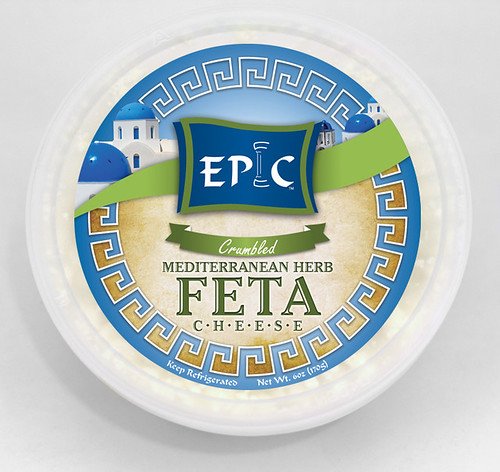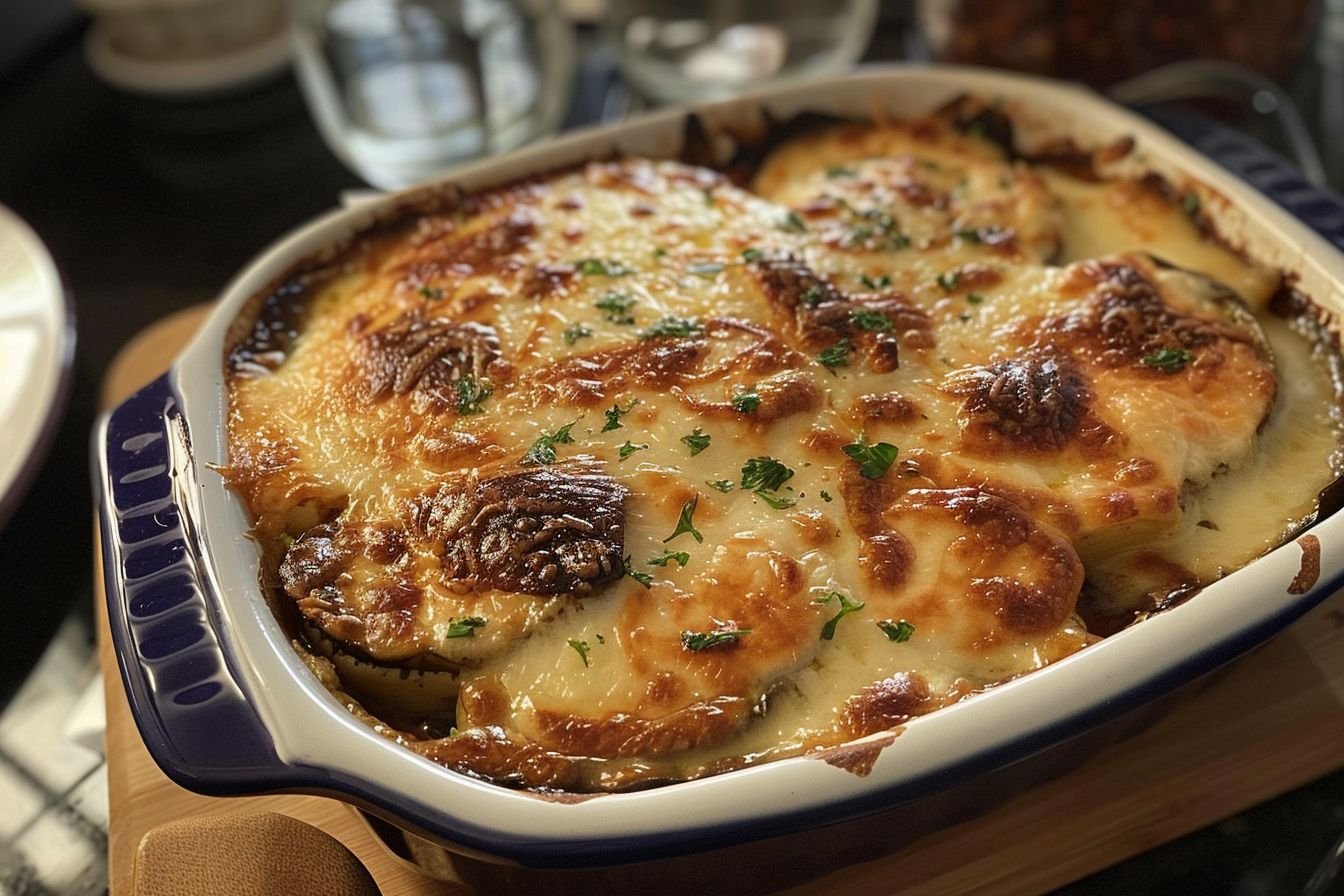Vegetarian moussaka with feta cheese is a vegetarian twist on the traditional; moussaka and is packed with flavor and hearty enough to satisfy even the biggest appetite.
To make this moussaka, you’ll need a few key ingredients, including eggplant, zucchini, potatoes, onion, garlic, lentils, and feta cheese. The sauce is made with milk, flour, butter, nutmeg, and egg, and the topping is a generous sprinkling of grated Parmesan cheese. With these ingredients, you’ll create a dish that is both creamy and savory, with just the right amount of spice and tanginess.
History of Vegetarian Moussaka
The dish has been around for centuries and has been adapted in various ways to suit different dietary requirements. Vegetarian moussaka is one such adaptation that has gained popularity in recent times.
The origins of moussaka can be traced back to the Middle East, where it was first made with meat and eggplant. The dish then spread to the Mediterranean region, where it underwent several changes to become what we know as moussaka today.
The vegetarian version of moussaka is a relatively new addition to the culinary world. It is believed to have originated in Greece, where the traditional recipe was modified to exclude meat and include vegetables like zucchini and mushrooms. The dish was further adapted to include feta cheese, which adds a tangy and salty flavor to the dish.
Today, vegetarian moussaka is a popular dish across the world and is enjoyed by people of all dietary preferences. It is a healthy and delicious alternative to the traditional meat-based moussaka and is an excellent source of vitamins and minerals.
Importance of Feta Cheese in Moussaka
Nutritional Benefits of Feta
Feta cheese is a great source of protein, calcium, and vitamin B12. It is also lower in fat and calories than many other types of cheese, making it a healthier option. In addition, feta cheese is rich in probiotics, which can help improve gut health and boost the immune system.
Cultural Significance of Feta in Greek Cuisine
Feta cheese has been a staple in Mediterranean cuisine for centuries. It is believed to have originated in ancient Greece, where it was used in a variety of dishes, including moussaka. Today, feta cheese is still a popular ingredient in many Greek dishes and is often used as a topping for salads, pizzas, and sandwiches.
In Greek culture, feta cheese is also associated with hospitality and generosity. It is often served as a welcoming snack to guests and is considered a symbol of friendship and goodwill.

Ingredients:
- 1 thinly sliced eggplant
- 1 tsp of salt (or as needed)
- 1 tbsp of olive oil (or more, if needed)
- 1 large thinly sliced zucchini
- 2 thinly sliced potatoes
- 1 sliced onion
- 1 chopped clove of garlic
- 1 tbsp of white vinegar
- 1 can (14.5 ounces) of whole peeled chopped tomatoes
- 1/2 can (14.5 ounces) of drained with liquid reserved lentils
- 2 tbsp of chopped fresh parsley
- 1 tsp of dried oregano
- Black pepper to taste
- 1 cup of crumbled feta cheese
Sauce:
- 1 1/4 cups of milk
- 2 tbsp of all-purpose flour
- 1 1/2 tbsp of butter
- 1 pinch of ground nutmeg
- Black pepper to taste
- 1 large egg, beaten
Topping:
- 1/4 cup of grated parmesan cheese
How to Make Vegetarian Moussaka with Feta Cheese?
Here are the instructions for making moussaka in a more formal tone and nine bullet points:
- Begin by salting the eggplant slices and setting them aside for 30 minutes. Rinse and thoroughly dry them with paper towels before proceeding to the next step.
- Preheat your oven to 375 degrees Fahrenheit (190 degrees Celsius). In a large skillet over medium-high heat, add olive oil and heat it. Cook the eggplant and zucchini slices in the hot oil until they are lightly browned, approximately 3 minutes per side. Utilize a slotted spoon to remove them and transfer them to a plate lined with paper towels for draining. Aim to reserve as much oil in the skillet as possible.
- If necessary, add more oil to the skillet and allow it to reach a high temperature. Cook the potato slices in the hot oil until browned, which should take between 3 and 5 minutes per side. Employ a slotted spoon to remove them and place them on a paper towel-lined plate for draining, similar to the eggplant and zucchini. Once again, aim to retain as much oil as possible in the skillet.
- Using the reserved oil in the skillet, sauté the onion and garlic until they are lightly browned, which should take roughly 5 to 7 minutes.
- Introduce vinegar to the skillet and bring it to a boil. Subsequently, reduce the heat to medium-low and simmer the mixture until the liquid reduces in volume and thickens.
- Stir in tomatoes, lentils, half of the lentil juice, parsley, and oregano. Season the mixture with salt and black pepper.
- Cover the skillet, reduce the heat to medium-low, and simmer the sauce for 15 minutes.
- In a 9×13-inch baking dish, create layers using one-third of the eggplant, half of the potatoes, one-third of the zucchini, and half of the feta cheese. Pour half of the tomato mixture over the vegetables. Repeat the layering process, ensuring the final layer consists of eggplant and zucchini.
- Preheat the oven to 375 degrees Fahrenheit (190 degrees Celsius) and bake the covered moussaka for 25 minutes. Next, prepare the béchamel sauce by whisking together milk, flour, and butter in a separate saucepan. Bring the mixture to a low boil, whisking constantly until it reaches a thick and smooth consistency. Season the sauce with nutmeg and black pepper. Remove it from the heat, allow it to cool for 5 minutes, and then incorporate the beaten egg. Pour the béchamel sauce over the vegetables and top with Parmesan cheese. Bake the moussaka uncovered for an additional 25 to 30 minutes, or until the sauce is bubbly and the top is slightly browned.
Serving Suggestions
Accompaniments
I love serving my vegetarian moussaka with a side salad. A simple green salad with a tangy vinaigrette dressing is the perfect accompaniment to balance the richness of the moussaka. You can also try serving it with some crusty bread to soak up all the delicious flavors.
If you’re looking for something heartier, you can serve the moussaka with a side of roasted vegetables. I like to roast some eggplant, zucchini, and bell peppers with a drizzle of olive oil and some herbs for added flavor. You can also try serving it with a side of couscous or quinoa for a complete meal.
Plating and Presentation
I like to keep plating simple and rustic. I spoon the moussaka onto a plate and top it with some crumbled feta cheese and chopped fresh parsley. You can also add a dollop of Greek yogurt on top for some extra creaminess.
To make it look even more appetizing, you can sprinkle some paprika or chili flakes on top for a pop of color. You can also garnish it with some olives or capers for added flavor and texture.
Remember, presentation is key! Make sure to serve the moussaka hot and fresh out of the oven for the best flavor and texture.
Leftover Storage and Reheating
Proper storage and reheating are key to maintaining the dish’s taste and texture. Here are some tips I’ve learned over the years:
Refrigeration Guidelines
To ensure your vegetarian moussaka stays fresh, store it in an airtight container in the refrigerator. It should be consumed within 3-4 days of cooking. If you’re storing it for longer, consider freezing it instead.
When reheating, reheat only the portion you plan to eat. Repeated reheating and cooling can lead to bacterial growth and spoilage.
Best Reheating Methods
There are several ways to reheat this moussaka. Here are some of my favorite ways to reheat:
- Oven: For even and gentle reheating, preheat your oven to 350°F (175°C). Cover the moussaka dish with foil and bake for 20-25 minutes, or until completely warmed through.
- Microwave: If you’re short on time, a microwave can reheat a single serving quickly. Place your portion in a microwave-safe dish and cover it with a lid or plastic wrap suitable for microwaves. Heat on high for 2-3 minutes, checking for doneness and stirring occasionally to ensure even heating. Be cautious, as the moussaka might heat unevenly.
- Stovetop: Reheating on the stovetop offers more control over the process. Heat a small amount of oil in a pan over medium heat. Add your moussaka portion and cover the pan with a lid. Cook for 5-7 minutes, stirring occasionally, until heated through.
Nutritional Information
Here’s a breakdown of the nutritional information for one serving of this vegetarian moussaka:
| Nutrient | Amount |
|---|---|
| Calories | 240 |
| Total Fat | 12g |
| Saturated Fat | 6g |
| Cholesterol | 58mg |
| Sodium | 425mg |
| Total Carbohydrates | 28g |
| Dietary Fiber | 5g |
| Sugars | 10g |
| Protein | 10g |
As you can see, this dish is a great source of fiber, and several essential vitamins and minerals. The eggplant and tomato sauce provide a good amount of fiber, while the feta cheese adds a healthy dose of calcium and protein.
Pairing with Wines and Beverages
This dish’s rich flavors and textures can be complemented by a variety of drinks, both alcoholic and non-alcoholic.
For those who prefer wine, a red wine like a Syrah or a Zinfandel pairs well with the bold flavors of the moussaka. The tannins in the wine help cut through the dish’s richness, while the fruity notes complement the tomato sauce and eggplant. If you prefer a white wine, a Chardonnay or a Sauvignon Blanc can also be a good choice, especially if the moussaka has a lighter, creamier sauce.
If you’re not a wine drinker, there are plenty of other options to consider. A cold glass of iced tea or lemonade can be refreshing and contrast nicely with the warm, savory moussaka. Alternatively, sparkling water or a light beer can be a good choice, especially if you want something to cleanse your palate between bites.
No matter what you choose, be sure to experiment with different options to find the perfect pairing for your taste buds. With so many flavors and textures in the moussaka, there’s sure to be a beverage that will complement and enhance the dish.
Conclusion
I have to say, this vegetarian moussaka with feta cheese is a real winner in my book. The combination of eggplant, tomato sauce, and creamy feta cheese is simply irresistible.
One of the things I love most about this dish is how versatile it is. You can serve it as a main course for a hearty dinner or as a side dish for a lighter meal. It’s perfect for vegetarians and meat-eaters alike, and it’s a great way to get some extra veggies into your diet.
Another thing I appreciate about this recipe is how easy it is to make. While moussaka can be a bit intimidating to prepare, this vegetarian version is much simpler and quicker to put together. Plus, it’s a great way to use any leftover vegetables in your fridge.
Overall, I highly recommend giving this vegetarian moussaka with feta cheese a try. It’s a delicious and satisfying dish that’s sure to become a new favorite in your recipe rotation.
You’ve probably heard it before – fresh vegetable salad pairs perfectly with this moussaka.
Get this salad with tahini recipe now (by clicking the image below):





